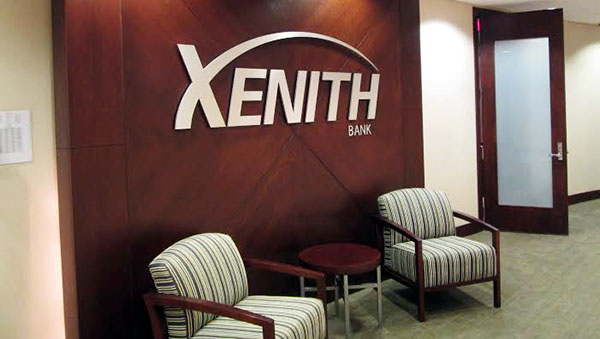Gaylon Layfield has been through mergers and acquisitions before.
As CEO of locally based Xenith Bank, he’s led the company through at least four deals that helped shape it into a $1 billion institution with a presence in three major markets in Virginia in less than a decade.
But the transaction Xenith announced late Wednesday – to combine with Virginia Beach-based Hampton Roads Bankshares in a $107 million deal – is different, Layfield said.
“I’d put all the others in a category of attractive, sort of middle-of-the-road opportunities. This one falls in the category of really transformative,” he said.
The pending deal would combine Xenith’s eight branches, $1 billion in assets and 125 employees with HRB’s 34-branch, $2 billion franchise that operates Bank of Hampton Roads, Gateway Bank and Shore Bank brands around Virginia, North Carolina and Maryland with more than 500 workers.
It will help transform Xenith from a bank that’s focused largely on business and commercial clients by combining it with a more consumer products-focused bank that also has a separate, in-house residential mortgage company.
Xenith’s branches have always been offices tucked away in larger office buildings, rather than traditional standalone retail branches. With HRB, it joins an organization with a wide retail branch presence.
Ultimately, the fusing of those two identities together and the resulting size is what helped drive Xenith in this direction, Layfield said.
“We’ve said it publicly, we have thought for a long time that in today’s environment, scale is awfully important,” Layfield said.
Combining with HRB, he said, “really moves the needle, brings a lot of capital to the table, geographic span and the scale on both sides.”
Despite being the smaller of the two parties, Xenith will be the surviving brand going forward, and Layfield will take the helm of the combined organization. Richmond will be the company’s headquarters.
Xenith shareholders will receive 4.4 shares of HRB common stock for each share of Xenith common stock. HRB shareholders will own 74 percent of the combined company, with Xenith shareholders holding the rest.
While Hampton Roads Bankshares is technically the acquirer in this case, both sides say the deal is about as close to a pure merger as two banks can get.
“This is as close as you can get to what I like to call a strategic merger,” Layfield said. “At its core it makes all kinds of business sense.”
Charles Johnston, who has been serving as HRB’s interim CEO since last fall, pointed to the fact that the top-level management of the combined companies will include a balance of executives from both sides and the boards will be split with directors from both companies.
“Mergers are fairly rare in this industry, but I would characterize it as a merger,” Johnston said.
Conversations about a deal began in November, Johnston said, after Layfield reached out to him with the idea. A letter of intent was in place by January, leading to Wednesday’s announcement.
“This deal always looked pretty strong from a strategic and financial point of view,” Johnston said. “A lot of discussions centered around social issues: How do you put these two companies together in a way that you get the strongest parts of each company into the new company and who’s going to do what and where?”
It helped that HRB was in flux in terms of permanent leadership at the top. Johnston, who had been an HRB board member since 2012, came out of retirement to act as CEO after the abrupt departure of Doug Glenn in September.
HRB as a result had been on the hunt for a new chief executive, and Johnston said Layfield fits the bill better than any of the other candidates.
Johnston liked the idea of being headquartered in the state capital, which made relocating the company’s legal headquarters to Richmond a non-issue.
And taking on the Xenith name worked out because HRB had been in the process of a brand transition. It was going to ditch the Bank of Hampton Roads and Gateway monikers in favor of Shore Bank.
The Xenith name, Layfield said, was created to be “geographically agnostic.”
The deal is also transformative from the standpoint of capital, Layfield said. Xenith currently has about $100 million in capital on-hand. That number will balloon by bringing in HRB’s capital and thanks to a deferred tax asset, which is essentially a long-term tax deduction that HRB has in its pocket from losses after the recession.
“When we put these two orgs together, we will have total capital of close to $450 million,” Layfield said.
That cash will help the new Xenith go after bigger business than it could on its own. The combination will increase its legal lending limit, taking its typical loan deal from its current range of $3 million-$8 million to twice that range, Layfield said.
That extra capital may also get put to use in other deals down the road, Layfield said.
“I don’t think that necessarily being at $3 billion (in assets) is by any means our ultimate aspiration,” he said. “So M&A will continue to be something we pay attention to.”
Johnston, who plans to return to retirement in Williamsburg, agreed.
“This is a building kind of a deal, where both sides have to be looking down the road a bit,” Johnston said.
Gaylon Layfield has been through mergers and acquisitions before.
As CEO of locally based Xenith Bank, he’s led the company through at least four deals that helped shape it into a $1 billion institution with a presence in three major markets in Virginia in less than a decade.
But the transaction Xenith announced late Wednesday – to combine with Virginia Beach-based Hampton Roads Bankshares in a $107 million deal – is different, Layfield said.
“I’d put all the others in a category of attractive, sort of middle-of-the-road opportunities. This one falls in the category of really transformative,” he said.
The pending deal would combine Xenith’s eight branches, $1 billion in assets and 125 employees with HRB’s 34-branch, $2 billion franchise that operates Bank of Hampton Roads, Gateway Bank and Shore Bank brands around Virginia, North Carolina and Maryland with more than 500 workers.
It will help transform Xenith from a bank that’s focused largely on business and commercial clients by combining it with a more consumer products-focused bank that also has a separate, in-house residential mortgage company.
Xenith’s branches have always been offices tucked away in larger office buildings, rather than traditional standalone retail branches. With HRB, it joins an organization with a wide retail branch presence.
Ultimately, the fusing of those two identities together and the resulting size is what helped drive Xenith in this direction, Layfield said.
“We’ve said it publicly, we have thought for a long time that in today’s environment, scale is awfully important,” Layfield said.
Combining with HRB, he said, “really moves the needle, brings a lot of capital to the table, geographic span and the scale on both sides.”
Despite being the smaller of the two parties, Xenith will be the surviving brand going forward, and Layfield will take the helm of the combined organization. Richmond will be the company’s headquarters.
Xenith shareholders will receive 4.4 shares of HRB common stock for each share of Xenith common stock. HRB shareholders will own 74 percent of the combined company, with Xenith shareholders holding the rest.
While Hampton Roads Bankshares is technically the acquirer in this case, both sides say the deal is about as close to a pure merger as two banks can get.
“This is as close as you can get to what I like to call a strategic merger,” Layfield said. “At its core it makes all kinds of business sense.”
Charles Johnston, who has been serving as HRB’s interim CEO since last fall, pointed to the fact that the top-level management of the combined companies will include a balance of executives from both sides and the boards will be split with directors from both companies.
“Mergers are fairly rare in this industry, but I would characterize it as a merger,” Johnston said.
Conversations about a deal began in November, Johnston said, after Layfield reached out to him with the idea. A letter of intent was in place by January, leading to Wednesday’s announcement.
“This deal always looked pretty strong from a strategic and financial point of view,” Johnston said. “A lot of discussions centered around social issues: How do you put these two companies together in a way that you get the strongest parts of each company into the new company and who’s going to do what and where?”
It helped that HRB was in flux in terms of permanent leadership at the top. Johnston, who had been an HRB board member since 2012, came out of retirement to act as CEO after the abrupt departure of Doug Glenn in September.
HRB as a result had been on the hunt for a new chief executive, and Johnston said Layfield fits the bill better than any of the other candidates.
Johnston liked the idea of being headquartered in the state capital, which made relocating the company’s legal headquarters to Richmond a non-issue.
And taking on the Xenith name worked out because HRB had been in the process of a brand transition. It was going to ditch the Bank of Hampton Roads and Gateway monikers in favor of Shore Bank.
The Xenith name, Layfield said, was created to be “geographically agnostic.”
The deal is also transformative from the standpoint of capital, Layfield said. Xenith currently has about $100 million in capital on-hand. That number will balloon by bringing in HRB’s capital and thanks to a deferred tax asset, which is essentially a long-term tax deduction that HRB has in its pocket from losses after the recession.
“When we put these two orgs together, we will have total capital of close to $450 million,” Layfield said.
That cash will help the new Xenith go after bigger business than it could on its own. The combination will increase its legal lending limit, taking its typical loan deal from its current range of $3 million-$8 million to twice that range, Layfield said.
That extra capital may also get put to use in other deals down the road, Layfield said.
“I don’t think that necessarily being at $3 billion (in assets) is by any means our ultimate aspiration,” he said. “So M&A will continue to be something we pay attention to.”
Johnston, who plans to return to retirement in Williamsburg, agreed.
“This is a building kind of a deal, where both sides have to be looking down the road a bit,” Johnston said.

